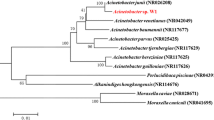Abstract
A bacterium utilizing 2-chloro-4,6-diamino-s-triazine (CAAT) as sole nitrogen source was isolated under a N2-free atmosphere and identified as Klebsiella pneumoniae. Concomitant to CAAT degradation the protein content increased and chloride was released into the medium. Under air and a N2-atmosphere no reduction of CAAT degradation resulted, though this strain is able to fix molecular nitrogen, but the decomposition accelerated under anaerobic conditions. The degradation rate increased continuously with increasing CAAT concentration. A continuous CAAT degradation without CAAT accumulation was possible up to a influx rate of 4.8 μmol·l−1 h−1 (dilution rate = 0.007 h−1). K. pneumoniae A2 was also able to utilize deethylsimazine (CEAT) and deethylatrazine (CIAT) as nitrogen source. Both under aerobic and anaerobic conditions CEAT could be degraded faster than CIAT. The degradation sequence of mixed s-triazines was cyanuric acid < CAAT < CEAT < CIAT, which was reflected by the degradation times of single compounds. Complete degradation was assumed for all investigated s-triazine derivatives.
Similar content being viewed by others
References
Behki RM, Khan SU (1986) Degradation of atrazine by Pseudomonas: N-dealkylation and dehalogenation of atrazine and its metabolites. J Agric Food Chem 34:746–749
Behki R, Topp E, Dick W, Germon P (1993) Metabolism of the herbicide atrazine by Rhodococcus strains. Appl Environ Microbiol 59:1955–1959
Cook AM (1987) Biodegradation of s-triazine xenobiotics. FEMS Microbiol Rev 46:93–116
Cook AM, Hütter R (1981a) Degradation of s-triazines: a critical view of biodegradation. In: Leisinger T, Cook AM, Nüesch J, Hütter R (eds) Microbial degradation of xenobiotics and recalcitrant compounds. Academic Press, London
Cook AM, Hütter R (1981b) s-Triazines as nitrogen source for bacteria. J Agric Food Chem 29:1135–1143
Cook AM, Hütter R (1984) Deethylsimazine: bacterial dechlorination, deamination and complete degradation. J Agric Food Chem 32:581–585
Cook AM, Hütter R (1986) Ring dechlorination of deethylsimazine by hydrolase from Rhodococcus corallinus. FEMS Microbiol Lett 5:843–848
Erickson LE, Lee KH (1989) Degradation of atrazine and related s-triazines. Crit Rev Environ Control 19:1–14
Ernst C (1993) Abbau und Verwertung verschiedener s-Triazin-Derivate durch freie und immobilisierte Bakterien. Ph.D. thesis, Mathematisch-Natuwissenschaftliche Fakultät, Westfälische Wilhelms Universität, Münster, Germany
Ernst C, Rehm HJ (1994) Development of a continuous system for the degradation of cyanuric acid by adsorbed Pseudomonas sp. NRRL B-12228. Appl Microbiol Biotechnol
Giardi MT, Giardina MC, Filacchioni G (1985) Chemical and biological degradation of primary metabolites of atrazine by a Nocardia strain. Agric Biol Chem 49:1551–1558
Giardina MC, Giardi MT, Filacchioni G (1980) 4-Amino-2-chloro-1,3,5-triazine: a new metabolite of atrazine by a soil bacterium. Agric Biol Chem 44:2067–2072
Giardina MC, Giardi MT, Filacchioni G (1982) Atrazine metabolism by Nocardia: eludication of initial pathway and synthesis of potential metabolites. Agric Biol Chem 46:1439–1445
Grossenbacher H (1986) Biodegradation von s-Triazin-Herbizid-Derivaten. Ph.D. thesis, ETH Nr. 8156, Zürich
Grossenbacher H, Horn C, Cook AM, Hütter R (1984) 2-Chloro-4-amino-1,3,5-triazine-6(5H)-one: A new intermediate in the biodegradation of chlorinated s-triazines. Appl Environ Microbiol 48:451–453
Grossenbacher H, Horn C, Cook AM, Hütter R (1985) Deamination of 6-chloro-1,3,5-triazine-2,4-diamine by Pseudomonas sp. strain A. Experientia 41:549
Haberer K, Normann S, Schmitz M (1988) Pflanzenschutzmittel aus der Sicht der öffentlichen Wasserversorgung. Teil 1. Vielfalt der Eigenschaften, Anwendungen und des Verhaltens von Pflanzenschutzmitteln. Wasser Boden 40:4–5
Harris CI, Kaufmann DD, Sheets TJ, Nash RG, Kearney PC (1968) Behavior and fate of s-triazines in soils. Adv Pest Control Res 8:1–55
Hogrefe W, Grossenbacher H, Cook AM, Hütter R (1985) Biological treatment specific for an industrial wastewater containing s-triazines. Biotechnol Bioeng 27:1291–1296
Hogrefe W, Grossenbacher H, Cook AM, Hütter R (1986) Biotreatment of s-triazine containing wastewater in fluidized bed reactor. Biotechnol Bioeng 28:1577–1581
Iwasaki I, Utsumi S, Ozawa T (1952) New colorimetric determination of chloride using mercuric thiocyanate and ferric ion. Bull Chem Soc Jp 25:226
Iwasaki I, Utsumi S, Hagino K, Ozawa T (1956) A new spectrophotometric method for the determination of small amounts of chloride using mercuric thiocyanate method. Bull Chem Soc Jpn 29:860–864
Kearney PC, Muldoon MT, Somich CJ, Ruth JM, Voaden DJ (1988) Biodegradation of ozonated atrazine as a wastewater disposal system. J Agric Food Chem 36:1301–1306
Lowry OH, Rosebrough NJ, Farr AL, Randall RJ (1951) Protein measurement with the Folin phenol reagent. J Biol Chem 193:265–275
Müller R, Lingens F (1987) Mechanismen der mikrobiellen Dehalogenierung von Chlorkohlenwasserstoffen. GIT Suppl. 5:5–9
Pfennig N, Lippert KD (1966) Über das Vitamin B12-Bedürfnis phototropher Schwefelbakterien. Arch Mikrobiol 55:245–256
Reineke W, Knackmuss HJ (1988) Microbial degradation of haloaromatics. Annu Rev Microbiol 42:263–287
Schmitz M (1988) Pflanzenschutzmittelbelastungen im Grund- und Trinkwasser in der Bundesrepublik Deutschland. In: Biologischer Abbau persistenter Substanzen? 5. DECHEMA-Fachgespräch Umweltschutz. Oldenbourg, München Wien, pp 49–51
Weatherburn MW (1967) Phenol-hypochlorite reaction for determination of ammonia. Anal Chem 39:971–974
Author information
Authors and Affiliations
Rights and permissions
About this article
Cite this article
Ernst, C., Rehm, H.J. Utilization of chlorinated s-triazines by a new strain of Klebsiella pneumoniae . Appl Microbiol Biotechnol 42, 763–768 (1995). https://doi.org/10.1007/BF00171959
Received:
Revised:
Accepted:
Issue Date:
DOI: https://doi.org/10.1007/BF00171959




